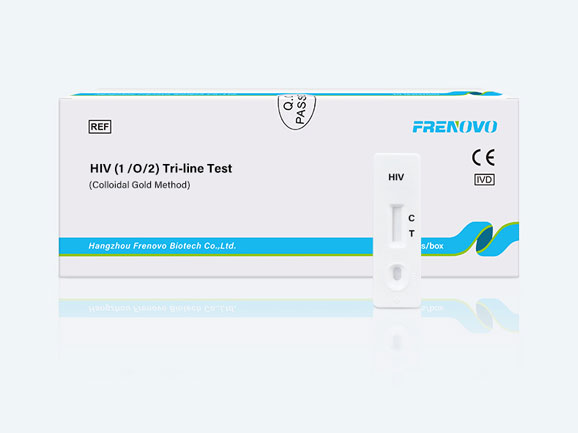HIV (1/O/2) Tri-line Antibody Rapid Test

وصف المنتج
The ADVIA Centaur HIV 1/O/2 Enhanced assay is an antigen bridging microparticle chemiluminometric immunoassay used for the detection of antibodies to the human immunodeficiency virus type 1, including Group O, and/or type 2 in serum or plasma.
The ADVIA Centaur HIV 1/O/2 Enhanced assay uses yeast recombinant derived antigens corresponding to the viral envelope and core proteins. Recombinant antigens include an HIV-1 envelope protein (gp41/120), an HIV-1 core protein (p24), and an HIV-2 envelope protein (gp36). A synthetic peptide is added for the detection of antibodies to HIV-1 group O.
The primary purpose of the ADVIA Centaur HIV 1/O/2 Enhanced essay is to aid in the diagnosis of HIV infection and AIDS. Specimens that are initially reactive should be retested in duplicate. Repeat reactivity is highly predictive of the presence of antibodies to HIV-1 and/or HIV-2 in specimens from people at risk for HIV infection and should be followed up with appropriate supplemental tests for HIV-1 and HIV-2 antibodies before making a diagnosis of HIV infection.
Product Description of HIV (1/O/2) Tri-line Antibody hiv test kit wholesale
This panel consists of six members, manufactured from human serum or plasma, with a range of concentrations of HIV antibodies and p24 antigen. Panel members were filtered through a 0.2 micron filter. ProClin® (0.1%) was added as a preservative.
The human immunodeficiency virus is the causative agent of acquired immunodeficiency syndrome (AIDS). AIDS was first described in the United States in 1981 and has become one of the leading causes of death worldwide. Despite educational efforts directed towards reducing the transmission of AIDS and increased advancements in treatment, the number of AIDS cases continue to increase. By the year 2010, it is estimated that there will be at least 45 million new human immunodeficiency virus (HIV) infections worldwide.
Human immunodeficiency virus type 1 (HIV-1) has been identified as the primary cause of acquired immunodeficiency syndrome (AIDS). This retrovirus, a member of the lentiviral
subfamily, is spread by sexual contact, exposure to infected blood or blood products, and perinatal transmission. In 1986 human immunodeficiency virus type 2 (HIV-2) was isolated
from AIDS patients in West Africa. These viruses share epitopes of the core proteins, but exhibit little or no cross-reactivity between the envelope glycoproteins.
Comparison of the nucleic acid sequences for HIV-1 and HIV-2 shows approximately 60% homology in the conserved genes, such as gag and pol (encoding core proteins), and 30 to40% homology in less conserved regions (encoding envelope proteins). HIV-1 has been subdivided into group M (subtypes A-H) and Group O.5 The routes of transmission of HIV-1 and HIV-2 are the same, however, in HIV-2 infections the transmission and the viral replication rate are much lower. Clinical studies have shown that in HIV-2 infections there is a slower disease progression than in HIV-1 infections. In HIV-2 infections there is a slower rate in the decline of CD4 T cells and reduced viremia. Individuals infected with HIV-2 generally have a better clinical outcome.
Come and get hiv rapid kit price .
Intended Use of HIV (1/O/2) Tri-line Antibody Rapid Test
HIV 1/2/O/p24 Qualification Panel QRX701 (2400-0158) is a panel of six members with established reactivity in anti-HIV-1, anti-HIV-2, anti-HIV-1 group O, HIVp24 antigen and combination assays. This panel may be used for training, qualifying, and re-qualifying technical personnel in the performance of tests for the detection of HIV. The panel may also be used as part of ongoing programs for lot acceptance and internal proficiency testing for HIV assays, to isolate system errors, in troubleshooting these assays, and as a component of a quality assurance program. For Research Use Only. Not for use in diagnostic procedures.

